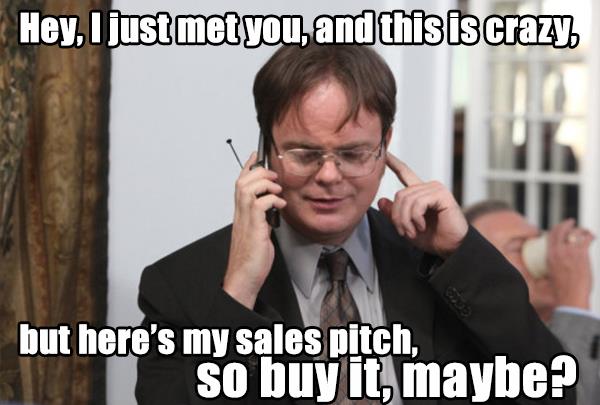5 Killer Ways to Justify Your Sales Call & Generate Demand
If there’s one thing I can’t stand, it’s when I hear sales reps calling under the guise of “just calling to check in,” or “just calling to say hi.” Sales reps take note: if you don’t give your prospects a clear, justifiable reason for calling, the conversation is over before it started. In order to keep a call going down the path to closing, you need to give a prospect a reason for why you’re calling.
 Can that reason be, “I’m calling to sell you ?” If your value prop can be digested in seconds, perhaps. But most B2B deals require some degree of demand generation to close deals. Speaking from experience, I can tell you that it’s a lot easier to close a deal when a prospect is actively researching your offerings.
Can that reason be, “I’m calling to sell you ?” If your value prop can be digested in seconds, perhaps. But most B2B deals require some degree of demand generation to close deals. Speaking from experience, I can tell you that it’s a lot easier to close a deal when a prospect is actively researching your offerings.
But where does this leave reps who are tasked with prospecting or following up with leads that have gone cold? My advice is this: come up with a justification for calling a prospect that simultaneously generates demand for what you’re selling. Here’s how!
Know Your Prospects!
When possible, know your prospects better than you know your Aunt Ethel. When I get a call from a sales rep who clearly doesn’t understand my job functions and pain points, it is rarely a long conversation. Obviously time is a factor, so tools like LinkedIn and Data.com are great platforms for quickly gathering data about your prospects. If your company has already done business with a prospect, then searching through their communications history in your CRM is a must.
Come Up with a Feasible Reason for Calling
Once you have some idea of a prospect’s industry and job functions, it isn’t difficult to devise a reason for your call. Want some help? Here are 5 “reasons” you can use to justify your sales call.
1. A Promotion/Coupon
Who doesn’t love saving money? Promotions or discounts are classic demand-generation tools that can create urgency and provide a perfect reason for your call. When approaching prospects with a promotion, frame it as an opportunity to help them maximize their budget or reduce costs.
For example:
“Hi , I’m reaching out because we’re running a limited-time promotion on . I thought it could be a great fit for based on what I’ve learned about your business.”
Timing is key here. Make sure your promotion aligns with their potential buying cycle or pain points. Promotions not only generate interest but also provide a natural segue into discussing your offerings more broadly.
2. An eBook/Whitepaper/Analyst Report
Content isn’t just for inbound marketing; it can be a powerful sales tool as well. If your marketing team has created high-value resources like eBooks, whitepapers, or analyst reports, leverage them to initiate conversations with prospects.
For instance, you could say:
“I noticed that your team is focused on , and we’ve put together an eBook that offers actionable insights on this topic. I’d love to send it over and hear your thoughts.”
The key here is relevance. Generic content won’t cut it. Instead, use hyper-focused materials on your prospect’s industry, challenges, or goals. This approach positions you as a helpful resource rather than a pushy salesperson. And don’t forget to follow up—after sharing the content, reach out to discuss their takeaways and how your solution aligns with their needs.
3. Webinars
Webinars are a fantastic tool for educating prospects and showcasing your expertise. While they’re often marketed broadly by marketing teams, sales reps can use webinars strategically to re-engage high-value prospects or follow up with leads that have gone cold.
Here’s an example of how to pitch a webinar to a prospect:
“Hi , I wanted to let you know about an upcoming webinar we’re hosting on . Given your interest in , I thought it might be valuable for you or your team to attend.”
Make sure to highlight the benefits of attending, such as gaining actionable insights, hearing from industry experts, or learning about new trends. Webinars can serve as a non-threatening entry point for sales conversations, giving prospects a reason to engage without feeling pressured to buy.
4. New Products/Product Updates
Introducing a new product or feature is one of the best reasons to reach out to prospects, especially those who have shown interest in your offerings before. New products not only create excitement but also provide an opportunity to discuss how your solution can address specific pain points.
For example:
“Hi , I wanted to let you know about our new . It’s designed to , and I think it could have a big impact on . Would you be open to a quick call to explore how it could fit your needs?”
This approach works particularly well for existing customers. Use the opportunity to upsell or cross-sell by showing how the new feature complements their current solution.
5. Events
If your company is attending or hosting an event, use it as an excuse to start a conversation. Events are a natural conversation starter and provide an easy way to engage without coming across as overly salesy.
For example:
“Hi , I saw that is coming up, and I wanted to check if you’re planning to attend. We’ll be there and would love to schedule some time to connect and discuss .”
Even if they’re not attending, this type of outreach can still spark interest. You can pivot the conversation to discuss their challenges and how your solution aligns with their goals.
To learn more about Revenue.io’s Intelligent Dialer for Salesforce, or to see a demo, contact Revenue.io Sales.
